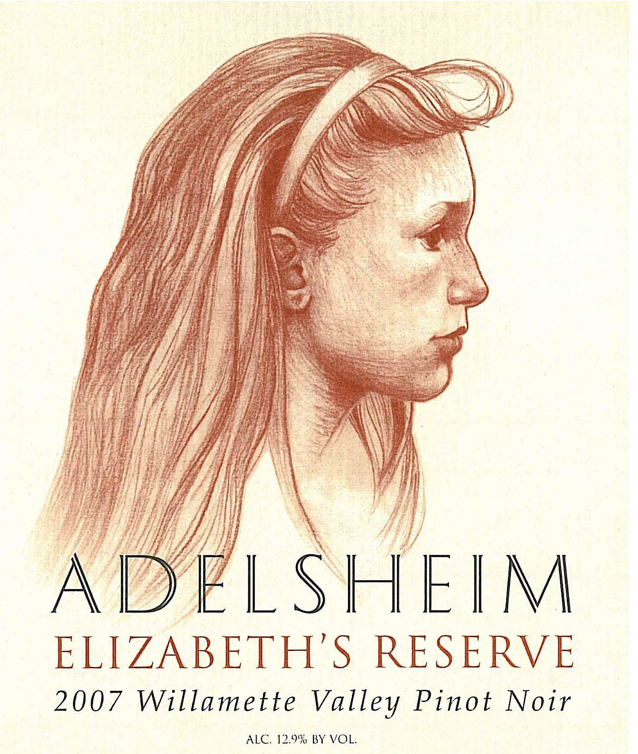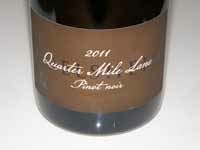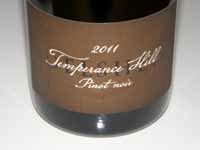David Adelsheim: A “Latecomer” Oregon Wine Pioneer
David Adelsheim likes to call himself a “latecomer” when talk turns to the pioneers of Oregon’s modern wine
industry. Although Richard Sommer, David Lett, Charles Coury, Dick Erath and Dick Ponzi preceded him by a
few years in planting vineyards and establishing wineries in Oregon, David not only founded an iconic
Willamette Valley winery, he became a revered figure in Oregon wine after having participated as a respected
spokesperson on practically every important issue facing the Oregon wine industry through the years. Despite
his prestigious accomplishments, he remains modest and unassuming, with a charming sense of humor, all
attributes that bring him much-deserved respect from his colleagues in Oregon.
David was uniquely one of the name early Oregon wine pioneers that did not immigrate to Oregon. Although
he moved to Portland from Kansas City with his family in 1954, he spent his formative years in Portland. After
studying at University of California at Berkeley and in Germany, he received a bachelor’s degree in German
literature from Portland State University. David became intrigued with artisan wines after a summer trip to
Europe in 1969 with his spouse Ginny, who was a talented sculptor and artist. He soon immersed himself in
the literature of winemaking, and dreamed of planting a vineyard in Oregon.
In 1971, the Adelsheims had a chance meeting with Dick Erath and Bill Blosser at a May Day party. They
directed the couple to seek out a south-facing slope with Jory soil appropriate for viticulture. Shortly after, they
found an appropriate field in the Chehalem Mountains near Newberg, a site that was in a unproven viticultural
area. In 1972, along with the help of friends and family, the Adelsheims first began the planting of 15 acres of
Pinot Noir, Chardonnay, Pinot Gris and Riesling at what became Quarter Mile Lane Vineyard. The original
Pinot Noir plantings in the 2.4-acre Block 1, planted in 1974, were obtained from Charles Coury and sold to
David as Pommard clone. Over time, these Pinot Noir selections have been found to be more likely Martini
clone or a mix of Martini and Pommard clone.
David expanded his wine knowledge by working as a sommelier in Portland restaurants, including the popular
L’Omellette for which David created the first wine list featuring an all-Oregon wine section. David also became
close friends with David Lett of The Eyrie Vineyards, and gained valuable winemaking expertise through him. In
1974, he spent two months in Burgundy, studying at Beaune’s Lycée Viticole, looking at the availability of
various cool climate grape varieties. In the Willamette Valley at the time, Pommard and Wädenswil clones
dominated the Pinot Noir plantings, along with the so-called “Coury clone,” which has never been
genealogically characterized.
Adelsheim Vineyard released its first wines in 1978, a grand total of 1,300 cases, including a Pinot Noir from
Quarter Mile Vineyard labeled “First Harvest,” tiny amounts of Chardonnay and Riesling from the same
vineyard, and Semillon and Merlot from purchased grapes. The initial 6,000-square-foot winery was established
in 1982 adjacent the Adelsheim’s home.
A second property in the Chehalem Mountains, Calkins Lane, was acquired in 1988, and the 36.48-acre
Calkins Lane Vineyard was established there, planted to Pinot Noir, Pinot Gris and Syrah. Also in 1988, 20
acres of a 60-acre site was leased across the road from the original estate vineyard, and planting began the
following year in what became known as Bryan Creek Vineyard. Jack and Lynn Loacker joined Adelsheim
Vineyard as co-owners in 1994 and assisted in the financing and planting of a 12-acre site on Ribbon Ridge,
Ribbon Springs Vineyard, an important source of the winery’s Pinot Noir and Pinot Gris grapes since 1998.
Today, Adelsheim Vineyard farms 11 estate vineyards over 229 acres in four Willamette Valley sub-AVAs. The
sites have considerable diversity, with both volcanic and sedimentary soils, variable elevations and sizes
ranging from small to large. In addition, grapes are sourced from 13 grower vineyards. Extensive details on all
the vineyard sources are available on the winery’s website. Of the 42,000 case annual production, 65%-75% is
estate grown depending on the vintage.
David handled all the winemaking from 1978 to 1985, followed by Don Kautzner who was the winemaker from
1986 to 1998. David Paige, a University of California at Davis graduate, came on board in 2001 and is the
current winemaker. A modern 35,000-square-foot winery with underground barrel storage was built in 1997 on
the Calkins Lane property, an extensive addition completed in 2008, and a tasting room opened there in 2009.
Chad Vargas has been the viticulturist and vineyard manager since 2006. David Adelsheim (center), David
Paige (right) and Chad Vargas (left) are pictured below. In 2010, David remarked humbly, “It’s a long distance
from 1978....(and) it’s exceeded anything I could have imagined.”
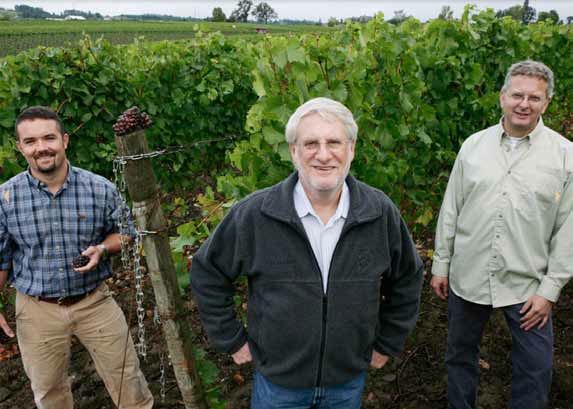
The Adelsheim Vineyard Willamette Valley Pinot Noir blend (so-named since 2004 and often based on Quarter
Mile Lane fruit), and Pinot Gris are the workhorses of the winery. Elizabeth’s Reserve Pinot Noir, named for the
Adelsheim’s daughter, Elizabeth, and sporting a label drawing of Elizabeth by Ginny, has consisted almost
exclusively of Chehalem Mountains fruit since 2000. The vineyard-designated Pinot Noirs (eight in the 2011
vintage) and a “Best of Vintage” Pinot Noir (inaugurated in 2001 with the release of “Vintage 29”) are the
prestige bottlings.
Since the fall of 2011, the Adelsheim Vineyard Pinot Noirs have had new labels. David notes, “We came to
realize that our previous labels did a good job of explaining our past, but did not address our aspirations about
the kind of company we intend to become in the future.” The winery and wines carry the L.I.V.E. certification
and many wines display the OCSW (Oregon Certified Sustainable Wine) logo as well.
The winery is located at 16800 NE Calkins Lane in Newberg and the website is www.adelsheim.com. The
Willamette Valley and Elizabeth Reserve Pinot Noirs are distributed nationally to nearly all states and
internationally. The tasting room is open daily from 11:00-4:00. If you are lucky to catch David at the winery,
you will find he has a wealth of knowledge about Oregon’s wine history.
Adelsheim Vineyard is reason enough to consider David one of Oregon’s most iconic vintners. However, it his
active and often leadership role in practically every important event that has defined Oregon’s fifty-year modern
wine history that is unrivaled. I have listed below some of David’s most notable accomplishments.
* Along with David Lett and others, he lobbied county planning committees to protect designated farmland from
residential growth (Senate Bills 100 and 101) and established the Oregon Department of Land Conservation
and Development.
* Along with Dick Erath and David Lett, he helped organize the industry and define a governing organization,
submitting a petition for the establishment of a wine commission of Oregon, the Oregon Wine Board, to which
he served as chair.
* He was a founding member of the Yamhill County Wineries Assocation (an archival photo below shows a
bearded David in the lower right).
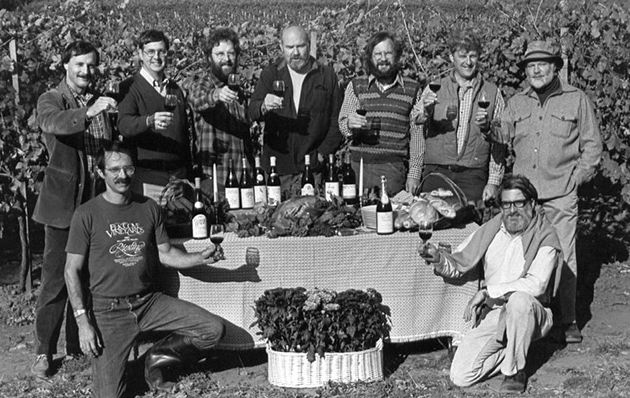
* He played a role in the creation of the Willamette Valley AVA and the smaller sub-AVAs.
* He was one of a group of winegrowers in 1986 who organized a wine festival in McMinnville, Oregon, known
as the International Pinot Noir Celebration (IPNC), now one of the foremost wine events in the world.
* He helped formulate Oregon wine labeling policies.
* Along with others, worked with Oregon State University to get the University a federal permit to import
grapevines, set up a quarantine and disease evaluation program, and create an industry program to evaluate
new clones.
* Along with Dr. David Heatherbell, Professor of Enology at Oregon State University, persuaded Dr. Bernard at
ONIVINs in France to share his Dijon Pinot Noir and Chardonnay clones with Oregon.
* He worked with Foundation Plant Services at University of California at Davis to find ways to bring the best
grapevine material to the United States, leading to importation of clones from the ENTAV-INRA research
program.
* He helped broker the deal that brought Maison Joseph Drouhin to Oregon.
* He was an organizer of the first Oregon Pinot Camp in 2000 for retailers and sommeliers.
* He is a supporter of ¡Salud! Oregon Wine Auction and a member of The Vintners Circle for that event.
* Has been and still is, an ambassador for Oregon wine.
* He received the Lifetime Achievement Award in 2012 from the Oregon Wine Board.
* He is a supporter and contributor to the Oregon Wine History Project™ at Linfield College in McMinnville.
I believe in the tenant, “Behind every great man is a great woman,” and that is certainly apt in the case of David
Adelsheim. His spouse, Ginny, worked in the vineyards at Adelsheim Vineyard in the early years, and hosted
and cooked for many winery related social events hosted in her home. She also was actively involved in the
marketing and distribution of the Adelsheim wines. Perhaps her most important contribution to the winery was
the artwork she did for the labels. From 1982 to 2009, Diana Lett’s portrait appeared on the Adelsheim
Vineyard Willamette Valley Pinot Noir. The purpose was to give women behind the scenes more recognition in
the wine industry. Additional portraits appeared on labels of Ginny’s sisters, close friends, and the Adelsheim’s
daughters as a tribute to those who helped establish the winery and brand. Ginny also drew the Adelsheim
Vineyard logo and artwork for other Oregon wine events such as ¡Salud! and IPNC. She now works with
veterans at a local Veteran’s Administration hospital, instructing them in art and sculpturing.
For more information on David and Ginny Adelsheim:
Oregon Wine History Project™: www.digitalcommons.linfield.edu. (includes audio and video interviews with
David Adelsheim)
Adelsheim Vineyard website: www.adelsheim.com. (an excellent website which includes a timeline of the
history of the Oregon wine industry and Adelsheim Vineyard, and succinct information on the major Pinot Noir
clones)
I wish to also acknowledge the following sources of ancillary information used in the preparation of this article:
Pacific Pinot Noir (2008), John Winthrop Haeger
The Boys Up North (1997), Paul Pintarich
I recently enjoyed the opportunity to taste through the 2011 vintage of Adelsheim Vineyard Pinot Noirs. The
wines display several outstanding qualities. Alcohols are unobtrusive, oak is deftly integrated, acidities are
bright and refreshing, and tannins are mild and respective, adding up to impressively balanced wines that are
approachable now, but in the case of the single vineyard wines in particular, capable of aging for ten or more
years. The cool growing season in 2011 produced wines that are relatively light in weight compared to say the
2009 vintage in Oregon, but the wines should put on more weight over time in the bottle, much like the wines
did from Oregon’s 2007 vintage. Adelsheim Vineyard Pinot Noirs can be considered exemplary reference
standards for the “Oregon style.”
David Paige’s winemaking regimen for Pinot Noir is as follows. He prefers to pick at modest Brix. The grapes
are de-stemmed into open top fermenters, cold soaked for 4 to 6 days, and fermentation is initiated by
inoculation. Malolactic fermentation is both natural and inoculated. The wines are aged at least 10 months in
25% new French oak barrels using several cooperages. The wines are all filtered, and fined on a case-by-case
basis. The 2011 Pinot Noirs have been in bottle over a year when tasted.
2011 Adelsheim Willamette Valley Pinot Noir
13.0% alc., pH 3.56, 16,566 cases, $32. 33rd vintage of this
wine. 76% of grapes sourced from Adelsheim estate vineyards with the largest percentage from the Chehalem
Mountains. The remaining 27% were derived from fourteen other non estate vineyards throughout the
Willamette Valley. Aged 10 months in 20% new French oak barrels.
·
Moderately light reddish-purple color in the
glass. Aromas of cherry, raspberry, cut flowers, resinous pine and cinnamon oak. Light in weight with brisk
acidity, featuring tart red cherry and cranberry flavors with oak in the background. A forward drinking wine for
the weekday dinner table.
Score: 86
2011 Adelsheim Elizabeth’s Reserve Willamette Valley Pinot Noir
13.0%
alc., pH 3.52, 1,306 cases, $55. A best of winery reserve, first bottled in 1986.
72% of the fruit comes from five of the Adelsheim estate vineyards located in the
Chehalem Mountains and Ribbon Ridge.
·
Moderately light reddish-purple hue in
the glass. Nicely perfumed with bright aromas of fresh cherry pie glaze, rose
petals, spice and oak. A cherry bombast with sneaky intensity, featuring bright,
clean flavors, suave tannins and a lively acid underpinning. Easy to like now
with it’s ample finish, this wine should benefit from cellaring.
Score: 89
2011 Adelsheim Boulder Bluff Vineyard Chehalem Mountains Pinot Noir
13.0% alc., pH 3.45, 372 cases,
$68. Lynn and Jack Loacker, co-owners of Adelsheim Vineyard, bought this 9.91-acre vineyard in 2000. Soils
are basaltic-origin (volcanic) clay loam. Basalt boulders give the vineyard its name. Three clones were used in
this bottling: QM-1 (from Charles Coury in 1974), “828” or AS-2, and Dijon 777. Aged 10 months in 28% new
French oak barrels.
·
Moderately light reddish-purple color in the glass. Appealing aromas of cherry, raspberry
and a hint of spice. The relatively light core of red cherry fruit shows good impact on entry and some finishing
power. The mouthwatering acidity, balanced tannins and complimentary oak add to the pleasure. Tasted the
following day from a previously opened and re-corked bottle, the wine had become more aromatic featuring hi-tone
cherry and baking spice aromas. The acidity became quite apparent, ending with a steely, mineral-driven
finish.
Score: 90
2011 Adelsheim Bryan Creek Vineyard Chehalem Mountains Pinot Noir
13.0% alc., pH 3.53, 375 cases,
$75. 19.2-acre vineyard planted to UCD 5, 113, 114, 115 in basaltic-origin (volcanic) clay loam soils. Relatively
high in elevation and one of the estate vineyards to be harvested. Aged in 27% new French oak barrels.
·
Moderately light reddish-purple hue in the glass. Demure, but appealing aromas of cherries, tea and rose
petals. Relatively light in weight, but very flavorful, offering juicy flavors of red cherries and berries wrapped in
soft tannins. Very polished with a refreshing vein of acidity and soprano finish.
Score: 91
2011 Adelsheim Calkins Lane Vineyard Chehalem Mountains Pinot Noir
13.0% alc., pH 3.50, 405 cases,
$68. This site was formerly a hazelnut and walnut orchard named after a family that settled the area in the
1890s and lived there into the 1960s. Pinot Noir first planted here in 1996 and the first single vineyard Pinot
Noir from the property came in the 2001 vintage. Clones are 115, 667 and 777 planted in marine sedimentary
soils. Warmest, lowest elevation and earliest to harvest of the estate vineyards. Aged 10 months in 34% new
French oak barrels.
·
Moderately light reddish-purple color in the glass. Well-endowed with bright aromas of
black cherries, cassis and iron. Enticing middleweight flavors of black cherry, pomegranate, cola and subtle
oak, balanced by ripe, firm tannins. Very polished and nicely balanced, finishing with a refreshing burst of
citrus-infused fruit.
Score: 91
2011 Adelsheim Quarter Mile Lane Vineyard Chehalem Mountains Pinot Noir
13.0% alc., pH 3.52, 82 cases, $105. First planted in 1972, this vineyard is
the oldest Adelsheim estate vineyard and is named for the road that forms the
northern boundary of the property. This wine comes from a 2.4-acre Block 1
planted in 1974 with what is apparently Martini clone or a mix of Martini and
Pommard clones. Basaltic-origin (volcanic) clay-loam soils. Aged 10 months in
33% new French oak barrels.
·
Moderately light reddish-purple color in the glass.
Plenty of energy in the hi-tone aromas of cherries, baking spice and oak. Very
classy on the palate with satisfying roundness and a velvety mouth feel. Flavors
of red cherries and berries are accented with a noticeable but not obtrusive oak
sheen. The juicy, vivid finish is exceptional. Still appealing the following day from a previously opened and recorked
bottle with soft, generous red fruit flavors.
Score: 93
2011 Adelsheim Ribbon Springs Vineyard Ribbon Ridge Pinot Noir
13.0% alc., pH 3.59, 352 cases, $68.
Ninth Ribbon Springs vineyard-designated wine. This 60-acre vineyard has high-density plantings of Pommard
(UCD5 and UCD4), Wädenswil (UCD1A), 4407, and Dijon clones 113, 114, 115, 667 and 777 in sandstonebased,
sedimentary soils. This wine is composed of UCD 4 and UCD5. Aged 10 months in 29% new French
oak barrels.
·
Medium reddish-purple color in the glass. Distinctive aromas of black fruits, clove, cola and oak
spice. Appealing fullness on the mid palate with moderately rich flavors of black cherry and blackberry framed
with a hint of spice and anise. Plenty of pizzaz to please with a satiny texture, polished tannins and a palate
staining black cherry explosion on the finish.
Score: 93
2011 Adelsheim Nicholas Vineyard Chehalem Mountains Pinot Noir
13.0% alc., pH 3.47, 161 cases, $90.
This vineyard was first planted by Nick and Sheila Nicholas in 2001 who make their own wines under the Anam
Cara label. 100% clone 667 planted in Laurelwood soils (wind-blown ice age sediment) covering basalt. Aged
10 months in 33% new medium-toast French oak barrels.
·
Moderately light reddish-purple color in the glass.
Deep aromas of fresh red cherry tart and spice are echoed on the palate. Husky tannins create a firm mouth
feel and a complimentary note of oak adds interest. The peacock tail finish is special. The wine still showed
exceptional character and balance the following day from a previously opened and re-corked bottle. Did I
mention the finish?
Score: 92
2011 Adelsheim Zenith Vineyard Eola-Amity Hills Pinot Noir
13.0% alc., pH 3.52, 143 cases, $90. Third
single vineyard wine from this vineyard that was originally planted in the early 1980s by Pat O’Connor. Kari
and Tim Ramey bought it in 2002 and renamed it, expanding the plantings to 70 acres. Clones are 667, “828,”
115, and Pommard planted in volcanic and sedimentary soils. Aged 10 months in 31% new medium-toast
French oak barrels.
·
Moderately light reddish-purple color in the glass. Seductive aromatics offering scents of
black cherries, forest floor and spice. Soft in the mouth and relatively light in weight, with appealing black
cherry flavor set off by an earthy note. The tannins are nicely balanced and the good acidity adds grip. Even
better the following day from a previously opened and re-corked bottle with glorious aromatics.
Score: 91

2011 Adelsheim Temperance Hill Vineyard Eola-Amity Hills Pinot Noir
13.0% alc., pH 3.60, 363 cases, $68. 100% clone 667 planted in
basaltic-origin (volcanic) soils. This 100-acre vineyard was established
by Edward and L.S. Koo in 1981. Adelsheim replanted on of the ideal
sections of the vineyard. A late ripening site. Fifth single vineyard
bottling. Aged 10 months in 33% new medium toast French oak barrels.
·
Medium reddish-purple color in the glass. The nose is striking with
bright aromas of Bing cherries, raspberries, and spice. Outstanding depth and
length of flavor featuring a core of dark red cherries and berries with a hint of
graham, cola and spice. Seductively ethereal in the mouth, with firm, supportive
tannins, and a long, long, long finish. A brilliant wine with superb balance. Still extraordinary when tasted the
following day from a previously opened and re-corked bottle.
Score: 94





